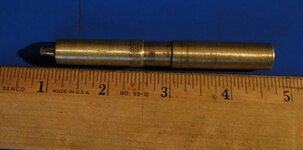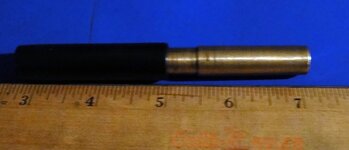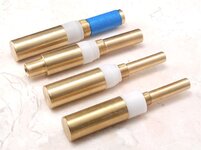studioso
Member
Hello fellow turners, I was wondering what is everyone's favorite method to hold the blanks (both body and cap, plus any section) when making a kitless pen.
I've outlined the methods I know here below, although I have not found a method that works for me (ie a method that will help me not screw up)
1- as per texatdurango AWSOME article on kitless pens, one way is to hold the pen in a chuck, then finish half a pen at a time.
Simple, in theory, however: I only have scroll chuck and I find it really hard to properly reallign the pen, and there is a step by the transition that can be felt when you run your finger over it. Also, this method only seem to work if the body is pretty straight, as a curve will not hold well in a chuck. Also, it will not work on wood, as you can't really do a ca finish half a pen at a time.
2-pin chuck. This method seems smart, although my poor sherline skills have prevented me to do a decent enough pin to fit my blanks. Also, it seems to me in theory, that by design a pin chuck will hold the blank off center. But I might be wrong.
3- those special expanding Mandrels, although they really just fit in 1-2 sizes brass tubes, and not in a true kitless.
3- Soligen's great tutorial on bulb pens shows some shop made brass Mandrels, and you thread the blanks onto them. Personally however, I would be very scared to hold the barrel by its threads, I am positive they will crack (on my blanks, with my skills).
So, what's your best method?
I've outlined the methods I know here below, although I have not found a method that works for me (ie a method that will help me not screw up)
1- as per texatdurango AWSOME article on kitless pens, one way is to hold the pen in a chuck, then finish half a pen at a time.
Simple, in theory, however: I only have scroll chuck and I find it really hard to properly reallign the pen, and there is a step by the transition that can be felt when you run your finger over it. Also, this method only seem to work if the body is pretty straight, as a curve will not hold well in a chuck. Also, it will not work on wood, as you can't really do a ca finish half a pen at a time.
2-pin chuck. This method seems smart, although my poor sherline skills have prevented me to do a decent enough pin to fit my blanks. Also, it seems to me in theory, that by design a pin chuck will hold the blank off center. But I might be wrong.
3- those special expanding Mandrels, although they really just fit in 1-2 sizes brass tubes, and not in a true kitless.
3- Soligen's great tutorial on bulb pens shows some shop made brass Mandrels, and you thread the blanks onto them. Personally however, I would be very scared to hold the barrel by its threads, I am positive they will crack (on my blanks, with my skills).
So, what's your best method?
Last edited:




